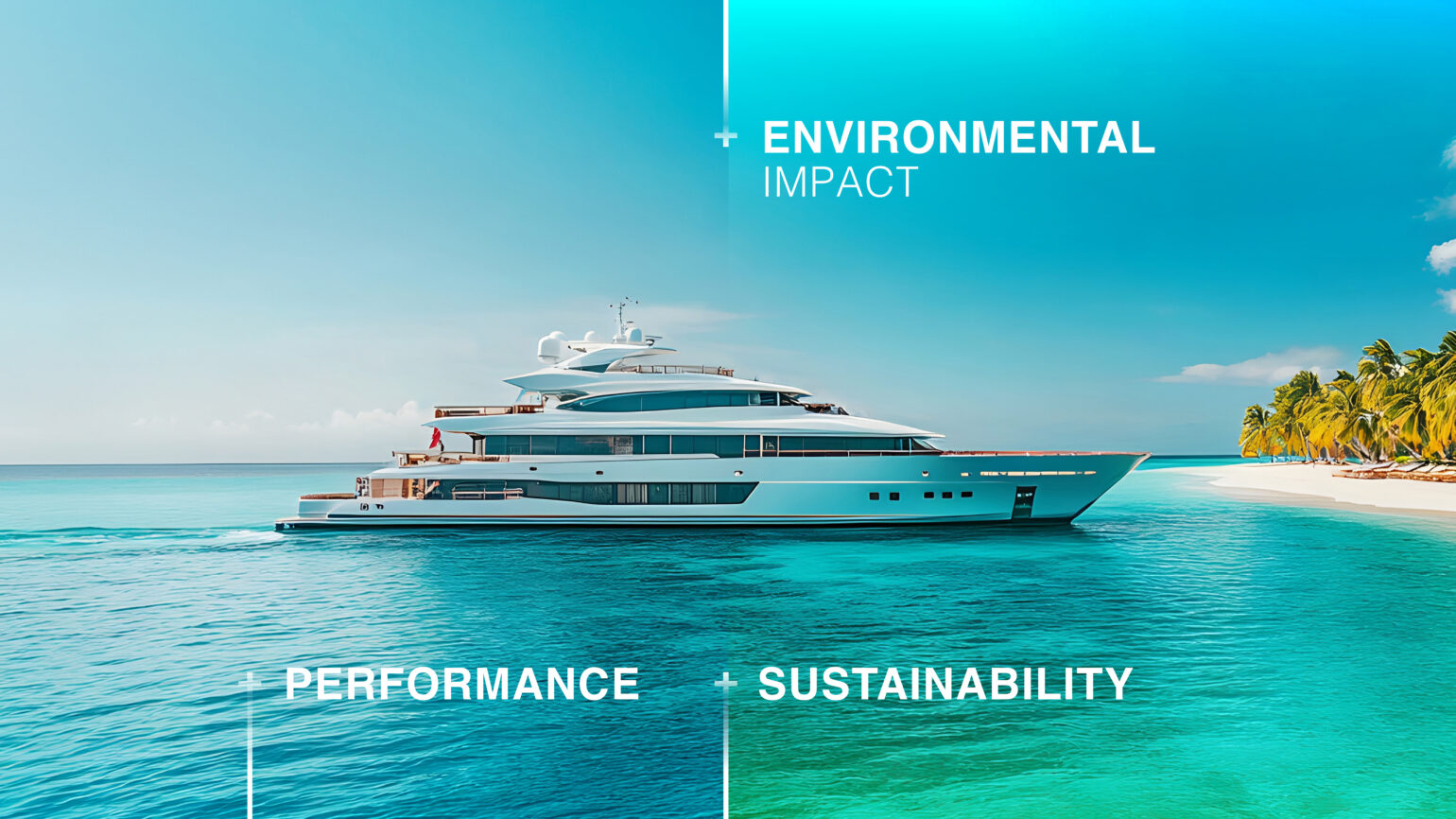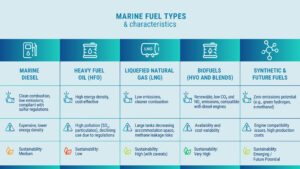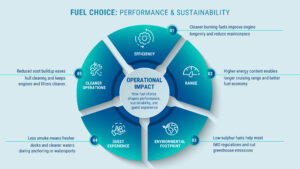
Luxury yachts rely on carefully chosen marine fuels to balance performance, range and environmental impact. Common fuel options range from traditional marine diesel (marine gasoil, MGO) and heavy fuel oil (HFO) to newer alternatives like liquefied natural gas (LNG), advanced biofuels (e.g. HVO) and even emerging synthetic “e-fuels”. Each fuel type has trade-offs in energy density, cost, emissions and availability. Below, we outline the major luxury yacht fuel types, compare their efficiency and eco-credentials, and summarise key pros/cons. We also explain how fuel choice affects yacht performance and spotlight Peninsula’s BFuture marine fuel – a premium sustainable HVO fuel designed for eco-conscious yachting.
Modern superyachts require reliable bunkering logistics, and the most common fuel options are Automotive Gas Oil (AGO), Marine Gas Oil (MGO), and Marine Diesel Oil (MDO). AGO, with its ultra-low sulphur content (10ppm), is often preferred as a premium, cleaner-burning choice, while MGO and MDO (≤0.1% sulphur, meeting IMO and ISO 8217 standards) remain widely available and compliant. These distillate fuels burn cleanly with low SOₓ and particulates and have a high cetane rating for efficient combustion, though they still produce CO₂ and some NOₓ, are less energy-dense than heavier oils, and command premium prices due to high demand. In contrast, heavy fuel oil (HFO) and liquefied natural gas (LNG), though common in commercial shipping, are impractical for luxury yachts: engines cannot burn HFO, and LNG’s bulky cryogenic tanks would sacrifice too much accommodation space. As a result, the sector is turning towards cleaner drop-in alternatives such as hydrotreated vegetable oil (HVO) and emerging synthetic “e-fuels.”
Each option involves trade-offs in energy density, cost, emissions, and availability. Below, we outline the major luxury yacht fuel types, compare their efficiency and eco-credentials, and highlight how fuel choice impacts performance, including Peninsula’s BFuture HVO – a premium sustainable fuel designed for eco-conscious yachting.
Automotive Gas Oil (AGO, 10ppm Sulphur)
AGO is the premium distillate fuel most commonly chosen by luxury yachts. With an ultra-low sulphur content (10ppm), AGO exceeds IMO limits (≤0.1% S) and complies with ISO 8217 standards. It burns very cleanly – producing minimal SOₓ, particulates, and smoke – while offering a high cetane rating for efficient combustion and smooth engine operation. Compared to MGO (0.1% sulphur), AGO is considered the higher-grade, cleaner option, and is often selected by owners who want the best performance and lowest emissions profile available today. Its main drawbacks are cost and lower energy density compared to heavier oils, meaning higher volumes are needed for long passages. Demand for AGO is also high, keeping prices at a premium.
Heavy Fuel Oil (HFO)
Heavy Fuel Oil (HFO) is the thick, residual product left over from refining crude oil. It is very cheap – typically ~30% cheaper than distillates like MGO – and very energy-dense per litre. This makes it popular for large ships with robust engines. However, HFO is extremely dirty: its combustion emits very high SOₓ, particulate matter and toxic pollutants. HFO requires heating and viscosity control before engine use. Because of its high sulfur content, HFO is now banned in most seas (IMO’s MARPOL cap is 0.5% S) unless ships install expensive exhaust scrubbers. In practice, few luxury yachts burn HFO today – the environmental and maintenance costs (scrubber systems, engine wear, soot) outweigh the fuel savings.
Liquefied Natural Gas (LNG)
LNG (liquefied natural gas) is mainly methane cooled to –162 °C. It contains virtually no sulfur and burns with almost no SOₓ or soot, greatly improving air quality. LNG also cuts NOₓ and CO₂ emissions compared to diesel (since natural gas is ~20% less carbon-intensive), and historically has been competitively priced. However, LNG fuel systems are complex and costly: engines must be retrofitted, and special cryogenic tanks (often ‘bullet’ tanks) are needed for on-board storage. Moreover, LNG’s climate benefits are now questioned because of methane slip – fugitive methane leaks during production or from the engine. Methane is a potent greenhouse gas (~80× CO₂ over 20 years), so even small leaks can negate CO₂ savings. Studies warn that on a full life-cycle basis LNG can warm the climate more than liquid fuels if methane slip is unchecked. Finally, LNG bunkering infrastructure remains limited – it is common in some cruise-fleet ports, but far less available in remote marinas. (Peninsula’s operations, for example, now include dedicated LNG bunker vessels to serve major cruising regions.)
Biofuels (HVO and Blends)
Biofuels for yachts are typically hydrotreated vegetable oils (HVO) or biodiesel blends. HVO is a second-generation renewable diesel made by hydrogenating waste oils/fats. It has almost no sulphur, a very high cetane number (>70) and a slightly higher energy content than fossil diesel. Crucially, HVO is a drop-in fuel: it can run in standard diesel engines without modification. Its lifecycle carbon footprint is dramatically lower – up to ~90% less CO₂ than conventional diesel. Peninsula’s BFuture fuel is one such HVO product, formulated to deliver high performance with sustainability. In practice HVO burns very cleanly, producing ~35% less visible smoke than diesel and reducing NOₓ emissions by an estimated ~25%. This means whiter exhaust plumes, no hull soot stains and a healthier deck atmosphere for guests. Yacht crews also find that HVO keeps engines and filters cleaner.
As biofuel production scales up and high-quality HVO becomes more widely certified, many see it as the leading short-term path to eco-friendly yacht fuel.
Synthetic and Future Fuels
Beyond bio-derived diesel, true zero-carbon fuels are emerging. These include green hydrogen (generated from renewable electricity) and green ammonia (made from hydrogen + nitrogen), or synthetic fuels like e-methanol (from CO₂ + green hydrogen). In theory, these “power-to-X” fuels emit no CO₂ at the point of use (ammonia combusts to N₂ and water, hydrogen to water) and virtually zero sulfur or soot. They could solve the climate problem if produced renewably. However, none are ready for yachts today: engines must be redesigned (fuel cells or new burners), and bunkering/storage challenges are daunting (cryogenics or toxicity in the case of ammonia). Production costs are also extremely high at present.
Fuel Type Comparison
Fuel Choice: Performance & Sustainability
Fuel selection strongly affects a yacht’s efficiency, range and environmental footprint. Cleaner-burning fuels (low-sulphur MGO or HVO) can improve engine longevity and reduce maintenance. For example, HVO fuel BFuture has higher energy content per metric tonne a higher cetane number than diesel, allowing engines to generate more power with smoother, more efficient combustion. In practice, this translates to better fuel economy and longer cruising range. Likewise, lower-smoke fuels mean cooler exhaust temperatures and less soot buildup – reducing strain on filters and components.
From a sustainability standpoint, fuel choice is critical. Low-sulfur fuels or alternatives help yachts comply with IMO regulations (MARPOL Annex VI) and avoid port bans. Fuels like HVO dramatically cut greenhouse and air-polluting emissions – HVO can reduce CO₂ emissions by up to 90% and NOₓ by ~25% compared to fossil diesel. In contrast, burning HFO or leaking methane (from LNG) would significantly worsen the climate impact. Reduced exhaust smoke also directly benefits guests and the environment: BFuture’s 35% smoke reduction means far less soot on the hull and in the air.
Industry trends reflect these drivers: Peninsula’s COO notes the company is “actively supplying biofuel and LNG” to customers, and expects these cleaner fuels to make up roughly 5–10% of bunker sales by 2030. Owners and captains are also investing in hybrid propulsion, better hull maintenance and other efficiency measures to complement greener fuels. Overall, fuel strategy – from tank storage to sourcing – is now a core part of yacht design and operation.
Peninsula’s BFuture: Marine Fuel for Superyachts
BFuture is a second-generation HVO (hydrotreated vegetable oil) fuel, formulated to strict standards for purity and performance. By using waste-based feedstocks and hydro-treatment, BFuture achieves a chemical profile very similar to conventional diesel, meaning it is fully “drop-in” – no changes to tanks, pumps, filters or engines are required. The fuel’s high cetane and energy density give yachts more range and power per tonne, while its clean-burning nature drastically cuts soot. In tests, BFuture reduced exhaust smoke by ~35% vs diesel, improving air and water quality around the yacht and eliminating the black residue often seen on hulls. Less smoke and odour means crew spend far less time cleaning and guests enjoy fresher decks and waters during anchoring or watersports.
BFuture’s robust specifications also make it operationally attractive. It has very low water content and stability (15+ year storage life), removing worries about fuel degradation or bacterial growth on long voyages. Its virtually zero sulfur content and lack of aromatics prevent corrosion and clogging, extending engine life. In short, BFuture combines the luxury performance yachts demand (smooth engines, long range, reliability) with best-in-class sustainability.
Conclusion
The choice of marine fuel on a luxury yacht has far-reaching effects on cost, performance and environmental impact. Traditional fuels like marine diesel (MGO) offer proven performance but still emit CO₂, while heavy fuel oil (HFO) is cheap but highly polluting. Newer options like LNG can cut some pollutants but introduce methane risk, and biofuels or e-fuels promise lower carbon at the expense of cost or complexity.
Peninsula’s experience illustrates this shift. By supplying high-grade fuels like HVO-based BFuture and progressively expanding LNG and biofuel bunkering, Peninsula aims to give owners every choice for greener yachting. As industry regulations tighten (e.g. IMO’s 2030/2050 targets) and charter guests demand eco-friendly operation, fuel type is a strategic decision. Ultimately, the future of luxury yachting will blend high performance with sustainability – and pioneering fuels like Peninsula’s BFuture marine fuel are already leading the way.



